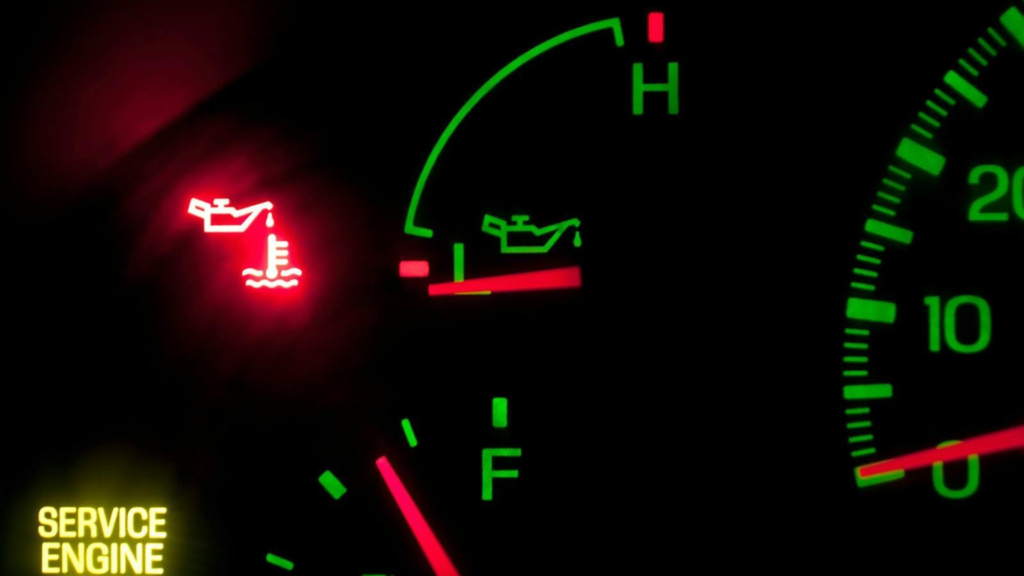
Volkswagen Golf Low Oil Pressure Light — Causes, Fixes, and Reset Guide

When the low oil pressure light illuminates on your Volkswagen Golf dashboard, it’s a serious alert. This warning indicates that your engine isn’t receiving the proper oil pressure necessary for lubrication and cooling. Ignoring it can lead to catastrophic engine damage.
In this comprehensive guide, we break down every possible cause, the step-by-step fixes, and how to safely reset the oil pressure warning light once the problem is solved.
- Understanding the VW Golf Oil Pressure System
- 1. Low Engine Oil Level
- 2. Incorrect Oil Viscosity
- 3. Faulty Oil Pressure Sensor
- 4. Failing Oil Pump
- 5. Oil Pressure Relief Valve Stuck Open
- 6. Clogged Oil Pickup Screen
- 7. Cracked Oil Pickup Tube
- 8. Clogged Oil Filter or Faulty Bypass Valve
- 9. Old or Degraded Engine Oil
- Diagnosing the Issue with an OBD-II Scanner
- How to Reset the VW Golf Low Oil Pressure Light
- FAQ — VW Golf Oil Pressure Warning
- Final Thoughts
Understanding the VW Golf Oil Pressure System
Your Golf’s oil pressure system keeps the engine lubricated by circulating oil through bearings, pistons, and other moving parts. When pressure drops below a safe threshold, the sensor signals the ECU to illuminate the oil can icon on your dashboard.
1. Low Engine Oil Level
A low oil level is the most frequent cause of the warning light. If there isn’t enough oil, the pump can’t maintain pressure.
How to Check and Correct:
- Park on level ground and wait for the engine to cool.
- Pull out the dipstick, wipe it clean, reinsert, and check the level.
- If it’s below the minimum mark, top up with the correct VW-approved engine oil.
Recommended oils for modern Golf engines:
| Engine Type | Recommended Oil | Viscosity |
|---|---|---|
| 1.4 TSI | VW 502 00 / 504 00 | 5W-30 |
| 2.0 TDI | VW 507 00 | 5W-30 |
| 1.5 eTSI | VW 504 00 | 0W-30 |
If the light remains on after topping up, continue diagnosing.
2. Incorrect Oil Viscosity
Using oil that’s too thick or too thin for your Golf can trigger the low oil pressure warning.
- Too thick (e.g., 10W-40): Restricts oil flow when cold.
- Too thin (e.g., 0W-20 in older engines): Fails to maintain pressure at high temperatures.
Always follow manufacturer viscosity specs found in your owner’s manual. Incorrect viscosity can cause long-term wear and poor performance.
3. Faulty Oil Pressure Sensor
The oil pressure sensor sends live readings to the ECU. When it fails, it may produce a false warning or fail to alert you when pressure is genuinely low.
You may be interested in reading Volkswagen Polo Engine Oil Guide: Complete Chart and Recommendations (2025 Edition)
Volkswagen Polo Engine Oil Guide: Complete Chart and Recommendations (2025 Edition)Symptoms of a Bad Sensor:
- Warning light flickers intermittently.
- OBD codes appear (e.g., P0520, P0521, P0522, P0523).
- No noticeable engine noise or performance drop.
Fix:
- Connect an OBD-II scanner.
- If codes point to oil pressure sensor malfunction, replace it.
- Clear codes and verify if the warning light remains off.
4. Failing Oil Pump
A worn or clogged oil pump can no longer maintain the necessary flow. This is a critical mechanical issue that demands immediate inspection.
Typical Warning Signs:
- Ticking or knocking noises from the engine.
- Sudden drops in pressure at idle.
- Increased engine temperature.
If confirmed, the oil pump must be replaced. Continuing to drive may lead to complete engine seizure.
5. Oil Pressure Relief Valve Stuck Open
The pressure relief valve regulates maximum pressure. If stuck open, oil circulates too freely, lowering system pressure.
Solution:
- Remove and inspect the valve.
- Clean or replace it if carbon deposits or sludge are found.
This issue often accompanies dirty oil or infrequent oil changes.
6. Clogged Oil Pickup Screen
The pickup screen, located in the sump, filters large debris before oil enters the pump. Over time, sludge buildup restricts flow.
Repair Process:
- Remove the oil pan.
- Clean the screen with solvent and compressed air.
- Replace the gasket and refill with fresh oil.
Neglecting this step can cause recurring low pressure issues even after oil changes.
7. Cracked Oil Pickup Tube
A cracked pickup tube allows air into the system, preventing the pump from maintaining consistent pressure.
Indicators:
- Intermittent pressure warnings.
- Audible gurgling or cavitation noises.
- Visible bubbles in drained oil.
Replacement is the only fix — the tube must create an airtight seal for proper suction.
8. Clogged Oil Filter or Faulty Bypass Valve
A severely clogged oil filter restricts flow, and if the bypass valve fails, oil cannot bypass the blockage, leading to pressure loss.
You may be interested in reading Volkswagen Polo Engine Oil Guide: Complete Chart and Recommendations (2025 Edition)
Volkswagen Polo Engine Oil Guide: Complete Chart and Recommendations (2025 Edition) How to Change a Volkswagen Polo Key Battery (Step-by-Step 2025 Guide)
How to Change a Volkswagen Polo Key Battery (Step-by-Step 2025 Guide)Solution Steps:
- Replace the oil filter immediately.
- Use only OEM or high-quality aftermarket filters.
- Ensure the bypass valve moves freely during inspection.
9. Old or Degraded Engine Oil
Oil naturally degrades over time, especially if it’s been overdue for change. Contaminants thicken it, reducing pressure and increasing wear.
Preventive Measures:
- Change oil at intervals specified in your Golf’s manual (typically every 10,000–15,000 km).
- Flush the engine if sludge buildup is suspected.
- Always use high-quality, VW-approved synthetic oils.
Diagnosing the Issue with an OBD-II Scanner
An OBD scanner can read diagnostic trouble codes (DTCs) and live oil pressure data.
Procedure:
- Plug into your vehicle’s OBD-II port.
- Scan for stored codes.
- Note live oil pressure readings — below 20 psi at idle indicates a problem.
- After repairs, clear the codes and test drive.
How to Reset the VW Golf Low Oil Pressure Light
Resetting the warning light is simple but must only be done after resolving the root cause.
Reset Steps:
- Connect your OBD-II scanner.
- Select Clear Fault Codes / Reset MIL.
- Turn ignition off, then start the engine again.
- Verify that the oil can symbol no longer appears.
⚠️ Warning: Resetting the light without fixing the underlying issue can lead to severe engine damage.
FAQ — VW Golf Oil Pressure Warning
Can I drive with the low oil pressure light on?
No. Pull over immediately, shut off the engine, and check oil levels. Driving under low oil pressure can destroy the engine within minutes.
Will adding oil fix the problem?
Only if the issue is due to low oil level. Persistent warnings require mechanical inspection.
Does a bad oil pump trigger fault codes?
Usually not directly. However, it can cause secondary codes linked to VVT system malfunction or engine misfires.
Can low oil pressure cause misfires?
Yes. Insufficient pressure can affect the valve timing system and reduce lubrication, resulting in poor combustion.
Will the check engine light turn on too?
Yes, in some cases. The ECU may detect low oil pressure as an engine fault and illuminate both the oil and check engine lights.
You may be interested in reading Volkswagen Polo Engine Oil Guide: Complete Chart and Recommendations (2025 Edition)
Volkswagen Polo Engine Oil Guide: Complete Chart and Recommendations (2025 Edition) How to Change a Volkswagen Polo Key Battery (Step-by-Step 2025 Guide)
How to Change a Volkswagen Polo Key Battery (Step-by-Step 2025 Guide) Volkswagen Polo Wheel Size and Fitment Guide (1975–2026)
Volkswagen Polo Wheel Size and Fitment Guide (1975–2026)Final Thoughts
The low oil pressure light on a Volkswagen Golf should never be ignored. Whether it’s a simple low oil level or a failing oil pump, addressing it promptly prevents costly repairs and keeps your engine performing at its best.
By maintaining regular oil changes, using the correct viscosity, and responding quickly to warnings, you ensure your Golf’s longevity and reliability for years to come.
If you want to know other articles similar to Volkswagen Golf Low Oil Pressure Light — Causes, Fixes, and Reset Guide you can visit the category Service and Parts.
Deja una respuesta





More content of your interest